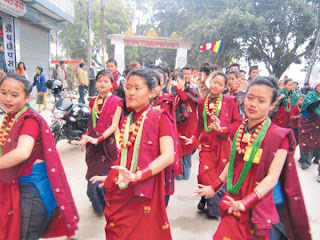Buddha's Birth Place
Over 2,600 years ago, the Buddha was born in a natural grove, where rare
and beautiful flowers bloomed and one could hear the humming of five
different types of bees. Queen Maya Devi was passing through this
earthly paradise on the way to her parents’ house when the pangs of
labor began. After bathing in a nearby pond the queen walked 25 paces,
took support of a sal tree and gave birth standing up. The infant Buddha
then took seven steps forward and declared that this would be his final
birth.
There are many versions of this well-known story, but
they all take place at the same sacred site: Lumbini, Nepal. In the time
since the Buddha’s birth, individuals as well as organizations have
played a role in discovering, maintaining, and developing Lumbini as a
Buddhist pilgrimage site, beginning with Ashoka, the Mauryan emperor of
the 3rd century B.C.E who first marked the place with one of his stone
edicts. In 1967 U Thant, then secretary general of the United Nations,
called international attention to the neglected site, in accordance with
a wish from the Nepali government. Presently, Lumbini is undergoing a
complex development process. Unlike long-established pilgrimage sites
such as Varanasi, Mecca, or Lourdes, Lumbini was rediscovered only a
little over a century ago.
5th Century B.C.E.Siddhartha Gautama is born.

 3rd Century B.C.E.
3rd Century B.C.E.Emperor Ashoka erects a stone pillar, proclaiming Lumbini as the Buddha’s birthplace.
5th and 7th centuries C.E.Two
famed Chinese pilgrims, the monks Fa-hsien (Faxian) and Hsuan-Tsang
(Xuanzang), make pilgrimages to Lumbini, writing down detailed travel
accounts of their journeys.
14th century C.E.
Ripu Malla, the king of Jumla (now a district in modern Nepal), carves his name on the upper portion of the Ashoka pillar.
1896The longstanding interest of the ruling British authorities in finding
the location of the neglected site bears fruit, and Lumbini is rediscovered during explorations.
 1967
1967UN secretary general U Thant visits Lumbini and presses for international cooperation to develop the Buddha’s birthplace.
1972The renowned Japanese architect Kenzo Tange is assigned to create the “master plan” for Lumbini. It was completed in 1978.
 1997
1997UNESCO declares Lumbini a World Heritage Site.
To watch a video about the Buddha’s birthplace today, click here.
To watch an interview with Venerable Metteyya about Lumbini, click
here. 
Images:
Envelop from Lumbini, 29 July, 1970, courtesy United Nations Archives;
Photograph of Ashokan Pillar © Ajay Pillarisetti; Photograph of U Thant
courtesy UN Photo/Grunbaum; Lumbini master plan courtesy of United
Nations Archive

